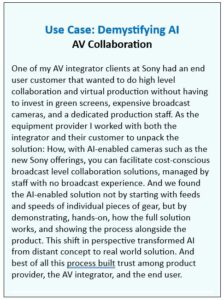AI (artificial intelligence) is being used in AV and digital signage devices such as screens and cameras, in content management software platforms, and in control and monitoring applications. It’s being tapped to modify the specs or performance of those devices or software platforms, either for workflow efficiencies or to have content respond to real-time data input and/or changing contextual cues.
We’ve all read and heard speculation about where AI is heading. As a senior sales engineer at a major AV equipment provider, my goal is not to come up with yet more wish lists for AI. Daily, I try to answer this question, for AV integrators out in the field: how do you make AI part of your initial conversations with your customers and potential customers, educate them about choices, and give them a clearer pathway to better AV ecosystems?
My experience in the field has given me insights you won’t hear during a trade show product pitch. Here are three lessons I’d like to share:
#1 What’s the Business Proposition?
If customers get bombarded at the outset with hyped-up promises – about any technology – they’re likely to be some combination of confused, skeptical, or pretty sure that you’re one in a long line of salespeople jumping on another tech trend bandwagon to try to get the project.
Don’t start with what cool things new AI technology can do. Start with the customer’s needs. Are they mainly interested in collaboration solutions? Then you know they’re facing new mandates to provide better experiences for their people, while meeting cost savings, efficiency, and sustainability goals.
But you can’t address all those needs at once. Drill down to practical considerations. Ask them – as they plan, design, and manage collaboration spaces – if they really know what is happening in their rooms today? Are those rooms doing all they need to do? AI-enabled solutions are not about the future, they’re about the ability to elevate any space, any room to a higher level of AV performance. Have you heard the expression “read the room?”
Don’t be intimidated by AI, and more importantly don’t let your customer be intimidated and confused. Learn to read both the customer, and literally, the room(s) in question.
#2 You’ve Learned to Talk the AI Talk. But Can You Walk the walk?
Show How AI Works. Do real life demos of AI-enabled AV. And show the process as well as the product. Because too much of what people think they know about AI in AV comes from press releases, product spec sheets, white papers, panel discussions at trade shows and online. Part of my job as a sales engineer is helping people get a closer look at how solutions really work. And there’s no better way to get into the weeds with the users than by doing hands-on demos. It’s important not just for the obvious benefit of demoing a product or software solution in real time in the field, but also to build trust between the tech provider, the AV integrator and the end user. Can you set up a videoconference between the AV equipment provider (with a sales engineer not just a salesperson), the AV integrator, and the end user? Does the AV equipment provider have an open door policy with the other people in the chain? Can you make a product available from a loan pool, as it’s being considered for an installation, to add confidence about the AI-enabled capabilities?
#3 The Best AI is About Related Technology Pieces Working Together – That’s Why the Best AV Systems Reflect Solution Partnerships
One of the brightest promises that AI offers our industry is better synergies between solutions from different providers. And it can, hopefully, get past the problem we’ve had for years: too many companies in the past trying to push either fully proprietary or mainly closed ecosystem solutions for AV.
AV-over-IP (AVoIP) has done a lot to point us all in a different direction, but we’re still not in a vendor-neutral or plug-and-play AV universe. As the industry moves to more software-based AV solutions and especially AI-enabled products, it’s more important than ever to make sure all the elements of your proposed AV ecosystem work happily together. AI is going to enable different products in AV and beyond to work together. That being said, it’s more important than ever to choose AV partners wisely.
Start with this question: does the big AV equipment partner that you’re choosing, as an integrator or high level end user, themselves have great “partners” for the careful building of AV systems including the ones with AI capabilities? (Want a good example? Look at Sony’s Alliance Partners program – who’s in it and why.)
Prioritize AI Solutions with Proven Business Benefits & Compatibility
I see in the field that as AI and other new generation technologies come to the forefront the best AV integrators and the most careful end users are going beyond just sourcing disparate products.
Increasingly, they’re looking at AI-enabled solutions. But they want to know how the solution offers a better business proposition not just a new technology approach. They are also looking for real world demos of the solutions before committing. And they need to know that the solutions they’re considering – including AI solutions – are compatible with best-in-class technology partners across a wide range of pro AV applications.
 Sony Electronics’ Kianna Pompa, is a Commercial Integrator’s 2023 40 Influencers Under 40, who recently transitioned from a sales engineer to a product manager, leading product development initiatives for the company’s display technology.
Sony Electronics’ Kianna Pompa, is a Commercial Integrator’s 2023 40 Influencers Under 40, who recently transitioned from a sales engineer to a product manager, leading product development initiatives for the company’s display technology.





